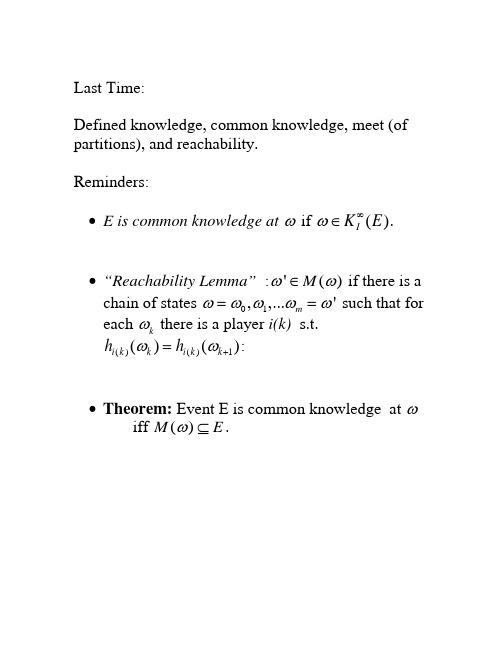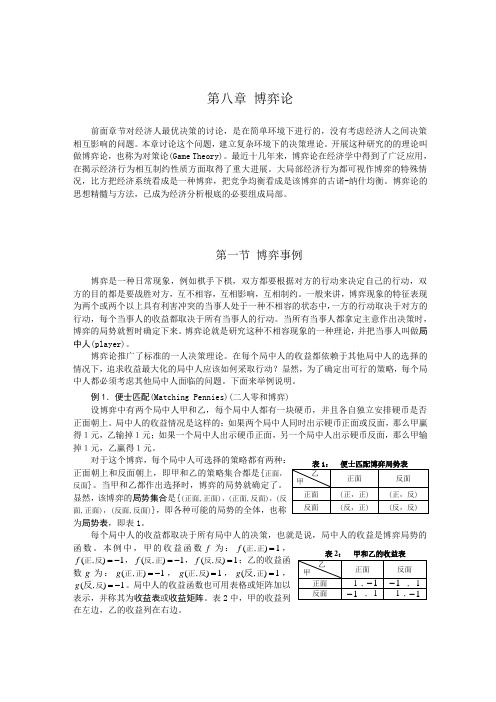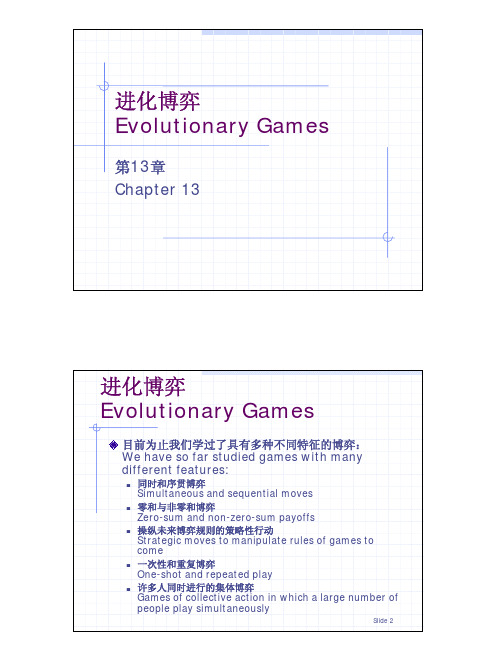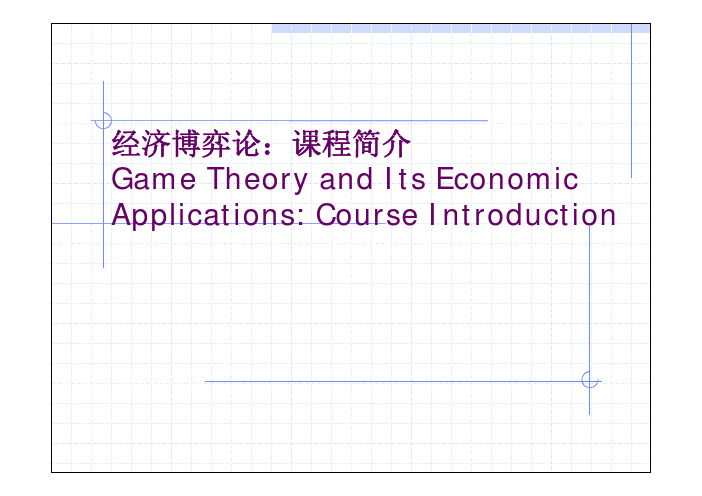清华大学博弈论讲义
博弈论讲义完整版

第一章 导论
注意两点: 1、是两个或两个以上参与者之间的对策论 当鲁滨逊遇到了“星期五”
石匠的决策与拳击手的决策的区别
第一章 导论
2、理性人假设 理性人是指一个很好定义的偏好,在面临定的约束条 件下最大化自己的偏好。 博弈论说起来有些绕嘴,但理解起来很好理解, 那就是每个对弈者在决定采取哪种行动时,不但要根 据自身的利益的利益和目的行事,而且要考虑到他的 决策行为对其他人可能的影响,通过选择最佳行动计 划,来寻求收益或效用的最大化。
不完全信息静态博弈-贝叶斯纳什均衡 海萨尼(1967-1968)
你 接受 求爱博弈: 品德优良者求爱 求爱者 求爱
100,100
不接受
-50,0 0,0
不求爱 0,0
100x+(-100)(1-x)=0 当x大于1/2时,接受求爱 求爱博弈: 品德恶劣者求爱 求爱者 接受 求爱 不求爱 0,0 你 不接受
问题:什么叫“完全而不完美信息博弈”?
第二章 完全信息静态博弈
一 博弈的基本概念及战略表述 二 占优战略(上策)均衡
三 重复剔除的占优均衡(严格下策反复消去法)
四 划线法
五 箭头法
六 纳什均衡
完全信息静态博弈
完全信息:每个参与人对所有其他参与人的特 征(包括战略空间、支付函数等)完全了解
同样的情形发生在: 公共产品的供给 美苏军备竞赛 经济改革 中小学生减负 ……
第一章 导论-囚徒困境
囚徒困境的性质:
个人理性和集体理性的矛盾; 个人的“最优策略”使整个“系统”处于不利 的状态。
思考:为什么会造成囚徒困境 是否由于“通讯”问题造成了囚徒困境? “要害”是否在于“利己主义”即“个人理 性”?
博弈论本科讲义

在中观经济研究中,劳动力经济学和金融理 论都有关于企业要素投入品市场的博弈模型, 即使在一个企业内部也存在博弈问题:工人之 间会为同一个升迁机会勾心斗角,不同部门之 间为争取公司的资金投入相互竞争;从宏观角 度看,国际经济学中有关于国家间的相互竞争 或相互串谋、选择关税或其他贸易政策的模型; 至于产业组织理论更是大量应用博弈论的方法 (见Jean Tirole的《产业组织理论》)。
如果n个参与人每人从自己的Si中选择一个策略 siategy profile),参与人i之外的其他参 与人的策略组合可记为s-i=( s1,s2,﹍,si-1 , si+1 ,﹍, sn)。
例如田忌的某个策略s田忌=上中下,或中下上, 等等;S田忌={上中下,上下中,中上下,中下 上 ,下上中,下中上}
贷市场的过高利息。此外,阿克尔洛夫还把信 息不对称运用于解释各种社会问题,比如因为信 息不对称,医疗保险市场上,老年人、个体劳动 者的医疗保险利益得不到保障。
三、基本概念
1、参与人Players:一个博弈中的决策主体, 他们各自的目的是通过选择行动(策略)以最 大化自己的目标函数/效用水平/支付函数。他们 可以是自然人或团体或法人,如企业、国家、 地区、社团、欧盟、北约等。 那些不作决策或虽做决策但不直接承担决 策后果的被动主体不是参与人,而只能当做环 境参数来处理。如指手划脚的看牌人、看棋人, 企业的顾问等。 对参与人的决策来说,最重要的是必须有
教材——P5 博弈论就是系统研究各种各 样博弈中参与人的合理选择及其 均衡的理论。
关于“经济博弈论”:
博弈论是研究人们在利益相互影响的格局 中的策略选择问题、是研究多人决策问题的理 论。而策略选择是人们经济行为的核心内容, 此外,经济学和博弈论的研究模式是一样的: 即强调个人理性,也就是在给定的约束条件下 追求效用最大化。可见,经济学和博弈论具 有内在的联系。在经济学和博弈论具有的这 种天然联系的基础上产生了经济博弈论。
lecture_2(博弈论讲义GameTheory(MIT))

Last Time:Defined knowledge, common knowledge, meet (of partitions), and reachability.Reminders:• E is common knowledge at ω if ()I K E ω∞∈.• “Reachability Lemma” :'()M ωω∈ if there is a chain of states 01,,...m 'ωωωωω== such that for each k ω there is a player i(k) s.t. ()()1()(i k k i k k h h )ωω+=:• Theorem: Event E is common knowledge at ωiff ()M E ω⊆.How does set of NE change with information structure?Suppose there is a finite number of payoff matrices 1,...,L u u for finite strategy sets 1,...,I S SState space Ω, common prior p, partitions , and a map i H λso that payoff functions in state ω are ()(.)u λω; the strategy spaces are maps from into . i H i SWhen the state space is finite, this is a finite game, and we know that NE is u.h.c. and generically l.h.c. in p. In particular, it will be l.h.c. at strict NE.The “coordinated attack” game8,810,11,100,0A B A B-- 0,010,11,108,8A B A B--a ub uΩ= 0,1,2,….In state 0: payoff functions are given by matrix ; bu In all other states payoff functions are given by . a upartitions of Ω1H : (0), (1,2), (3,4),… (2n-1,2n)... 2H (0,1),(2,3). ..(2n,2n+1)…Prior p : p(0)=2/3, p(k)= for k>0 and 1(1)/3k e e --(0,1)ε∈.Interpretation: coordinated attack/email:Player 1 observes Nature’s choice of payoff matrix, sends a message to player 2.Sending messages isn’t a strategic decision, it’s hard-coded.Suppose state is n=2k >0. Then 1 knows the payoffs, knows 2 knows them. Moreover 2 knows that 1knows that 2 knows, and so on up to strings of length k: . 1(0n I n K n -Î>)But there is no state at which n>0 is c.k. (to see this, use reachability…).When it is c.k. that payoff are given by , (A,A) is a NE. But.. auClaim: the only NE is “play B at every information set.”.Proof: player 1 plays B in state 0 (payoff matrix ) since it strictly dominates A. b uLet , and note that .(0|(0,1))q p =1/2q >Now consider player 2 at information set (0,1).Since player 1 plays B in state 0, and the lowest payoff 2 can get to B in state 1 is 0, player 2’s expected payoff to B at (0,1) is at least 8. qPlaying A gives at most 108(1)q q −+−, and since , playing B is better. 1/2q >Now look at player 1 at 1(1,2)h =. Let q'=p(1|1,2), and note that '1(1)q /2εεεε=>+−.Since 2 plays B in state 1, player 1's payoff to B is at least 8q';1’s payoff to A is at most -10q'+8(1-q) so 1 plays B Now iterate..Conclude that the unique NE is always B- there is no NE in which at some state the outcome is (A,A).But (A,A ) is a strict NE of the payoff matrix . a u And at large n, there is mutual knowledge of the payoffs to high order- 1 knows that 2 knows that …. n/2 times. So “mutual knowledge to large n” has different NE than c.k.Also, consider "expanded games" with state space . 0,1,....,...n Ω=∞For each small positive ε let the distribution p ε be as above: 1(0)2/3,()(1)/3n p p n ee e e -==- for 0 and n <<∞()0p ε∞=.Define distribution by *p *(0)2/3p =,. *()1/3p ∞=As 0ε→, probability mass moves to higher n, andthere is a sense in which is the limit of the *p p εas 0ε→.But if we do say that *p p ε→ we have a failure of lower hemi continuity at a strict NE.So maybe we don’t want to say *p p ε→, and we don’t want to use mutual knowledge to large n as a notion of almost common knowledge.So the questions:• When should we say that one information structure is close to another?• What should we mean by "almost common knowledge"?This last question is related because we would like to say that an information structure where a set of events E is common knowledge is close to another information structure where these events are almost common knowledge.Monderer-Samet: Player i r-believes E at ω if (|())i p E h r ω≥.()r i B E is the set of all ω where player i r- believesE; this is also denoted 1.()ri B ENow do an iterative definition in the style of c.k.: 11()()rr I i i B E B E =Ç (everyone r-believes E) 1(){|(()|())}n r n ri i I B E p B E h r w w -=³ ()()n r n rI i i B E B =ÇEE is common r belief at ω if ()rI B E w ¥ÎAs with c.k., common r-belief can be characterized in terms of public events:• An event is a common r-truism if everyone r -believes it when it occurs.• An event is common r -belief at ω if it is implied by a common r-truism at ω.Now we have one version of "almost ck" : An event is almost ck if it is common r-belief for r near 1.MS show that if two player’s posteriors are common r-belief, they differ by at most 2(1-r): so Aumann's result is robust to almost ck, and holds in the limit.MS also that a strict NE of a game with knownpayoffs is still a NE when payoffs are "almost ck” - a form of lower hemi continuity.More formally:As before consider a family of games with fixed finite action spaces i A for each player i. a set of payoff matrices ,:l I u A R ->a state space W , that is now either finite or countably infinite, a prior p, a map such that :1,,,L l W®payoffs at ω are . ()(,)()w u a u a l w =Payoffs are common r-belief at ω if the event {|()}w l w l = is common r belief at ω.For each λ let λσ be a NE for common- knowledgepayoffs u .lDefine s * by *(())s l w w s =.This assigns each w a NE for the corresponding payoffs.In the email game, one such *s is . **(0)(,),()(,)s B B s n A A n ==0∀>If payoffs are c.k. at each ω, then s* is a NE of overall game G. (discuss)Theorem: Monder-Samet 1989Suppose that for each l , l s is a strict equilibrium for payoffs u λ.Then for any there is 0e >1r < and 1q < such that for all [,1]r r Î and [,1]q q Î,if there is probability q that payoffs are common r- belief, then there is a NE s of G with *(|()())1p s s ωωω=>ε−.Note that the conclusion of the theorem is false in the email game:there is no NE with an appreciable probability of playing A, even though (A,A) is a strict NE of the payoffs in every state but state 0.This is an indirect way of showing that the payoffs are never ACK in the email game.Now many payoff matrices don’t have strictequilibria, and this theorem doesn’t tell us anything about them.But can extend it to show that if for each state ω, *(s )ω is a Nash (but not necessarily strict Nash) equilibrium, then for any there is 0e >1r < and 1q < such that for all [,1]r r Î and [,1]q q Î, if payoffs are common r-belief with probability q, there is an “interim ε equilibria” of G where s * is played with probability 1ε−.Interim ε-equilibria:At each information set, the actions played are within epsilon of maxing expected payoff(((),())|())((',())|())i i i i i i i i E u s s h w E u s s h w w w w e-->=-Note that this implies the earlier result when *s specifies strict equilibria.Outline of proof:At states where some payoff function is common r-belief, specify that players follow s *. The key is that at these states, each player i r-believes that all other players r-believe the payoffs are common r-belief, so each expects the others to play according to s *.*ΩRegardless of play in the other states, playing this way is a best response, where k is a constant that depends on the set of possible payoff functions.4(1)k −rTo define play at states in */ΩΩconsider an artificial game where players are constrained to play s * in - and pick a NE of this game.*ΩThe overall strategy profile is an interim ε-equilibrium that plays like *s with probability q.To see the role of the infinite state space, consider the"truncated email game"player 2 does not respond after receiving n messages, so there are only 2n states.When 2n occurs: 2 knows it occurs.That is, . {}2(0,1),...(22,21,)(2)H n n =−−n n {}1(0),(1,2),...(21,2)H n =−.()2|(21,2)1p n n n ε−=−, so 2n is a "1-ε truism," and thus it is common 1-ε belief when it occurs.So there is an exact equilibrium where players playA in state 2n.More generally: on a finite state space, if the probability of an event is close to 1, then there is high probability that it is common r belief for r near 1.Not true on infinite state spaces…Lipman, “Finite order implications of the common prior assumption.”His point: there basically aren’t any!All of the "bite" of the CPA is in the tails.Set up: parameter Q that people "care about" States s S ∈,:f S →Θ specifies what the payoffs are at state s. Partitions of S, priors .i H i pPlayer i’s first order beliefs at s: the conditional distribution on Q given s.For B ⊆Θ,1()()i s B d =('|(')|())i i p s f s B h s ÎPlayer i’s second order beliefs: beliefs about Q and other players’ first order beliefs.()21()(){'|(('),('))}|()i i j i s B p s f s s B h d d =Îs and so on.The main point can be seen in his exampleTwo possible values of an unknown parameter r .1q q = o 2qStart with a model w/o common prior, relate it to a model with common prior.Starting model has only two states 12{,}S s s =. Each player has the trivial partition- ie no info beyond the prior.1122()()2/3p s p s ==.example: Player 1 owns an asset whose value is 1 at 1θ and 2 at 2θ; ()i i f s θ=.At each state, 1's expected value of the asset 4/3, 2's is 5/3, so it’s common knowledge that there are gains from trade.Lipman shows we can match the players’ beliefs, beliefs about beliefs, etc. to arbitrarily high order in a common prior model.Fix an integer N. construct the Nth model as followsState space'S ={1,...2}N S ´Common prior is that all states equally likely.The value of θ at (s,k) is determined by the s- component.Now we specify the partitions of each player in such a way that the beliefs, beliefs about beliefs, look like the simple model w/o common prior.1's partition: events112{(,1),(,2),(,1)}...s s s 112{(,21),(,2),(,)}s k s k s k -for k up to ; the “left-over” 12N -2s states go into 122{(,21),...(,2)}N N s s -+.At every event but the last one, 1 thinks the probability of is 2/3.1qThe partition for player 2 is similar but reversed: 221{(,21),(,2),(,)}s k s k s k - for k up to . 12N -And at all info sets but one, player 2 thinks the prob. of is 1/3.1qNow we look at beliefs at the state 1(,1)s .We matched the first-order beliefs (beliefs about θ) by construction)Now look at player 1's second-order beliefs.1 thinks there are 3 possible states 1(,1)s , 1(,2)s , 2(,1)s .At 1(,1)s , player 2 knows {1(,1)s ,2(,1)s ,(,}. 22)s At 1(,2)s , 2 knows . 122{(,2),(,3),(,4)}s s s At 2(,1)s , 2 knows {1(,2)s , 2(,1)s ,(,}. 22)sThe support of 1's second-order beliefs at 1(,1)s is the set of 2's beliefs at these info sets.And at each of them 2's beliefs are (1/3 1θ, 2/3 2θ). Same argument works up to N:The point is that the N-state models are "like" the original one in that beliefs at some states are the same as beliefs in the original model to high but finite order.(Beliefs at other states are very different- namely atθ or 2 is sure the states where 1 is sure that state is2θ.)it’s1Conclusion: if we assume that beliefs at a given state are generated by updating from a common prior, this doesn’t pin down their finite order behavior. So the main force of the CPA is on the entire infinite hierarchy of beliefs.Lipman goes on from this to make a point that is correct but potentially misleading: he says that "almost all" priors are close to a common. I think its misleading because here he uses the product topology on the set of hierarchies of beliefs- a.k.a topology of pointwise convergence.And two types that are close in this product topology can have very different behavior in a NE- so in a sense NE is not continuous in this topology.The email game is a counterexample. “Product Belief Convergence”:A sequence of types converges to if thesequence converges pointwise. That is, if for each k,, in t *i t ,,i i k n k *δδ→.Now consider the expanded version of the email game, where we added the state ∞.Let be the hierarchy of beliefs of player 1 when he has sent n messages, and let be the hierarchy atthe point ∞, where it is common knowledge that the payoff matrix is .in t ,*i t a uClaim: the sequence converges pointwise to . in t ,*i t Proof: At , i’s zero-order beliefs assignprobability 1 to , his first-order beliefs assignprobability 1 to ( and j knows it is ) and so onup to level n-1. Hence as n goes to infinity, thehierarchy of beliefs converges pointwise to common knowledge of .in t a u a u a u a uIn other words, if the number of levels of mutual knowledge go to infinity, then beliefs converge to common knowledge in the product topology. But we know that mutual knowledge to high order is not the same as almost common knowledge, and types that are close in the product topology can play very differently in Nash equilibrium.Put differently, the product topology on countably infinite sequences is insensitive to the tail of the sequence, but we know that the tail of the belief hierarchy can matter.Next : B-D JET 93 "Hierarchies of belief and Common Knowledge”.Here the hierarchies of belief are motivated by Harsanyi's idea of modelling incomplete information as imperfect information.Harsanyi introduced the idea of a player's "type" which summarizes the player's beliefs, beliefs about beliefs etc- that is, the infinite belief hierarchy we were working with in Lipman's paper.In Lipman we were taking the state space Ω as given.Harsanyi argued that given any element of the hierarchy of beliefs could be summarized by a single datum called the "type" of the player, so that there was no loss of generality in working with types instead of working explicitly with the hierarchies.I think that the first proof is due to Mertens and Zamir. B-D prove essentially the same result, but they do it in a much clearer and shorter paper.The paper is much more accessible than MZ but it is still a bit technical; also, it involves some hard but important concepts. (Add hindsight disclaimer…)Review of math definitions:A sequence of probability distributions converges weakly to p ifn p n fdp fdp ®òò for every bounded continuous function f. This defines the topology of weak convergence.In the case of distributions on a finite space, this is the same as the usual idea of convergence in norm.A metric space X is complete if every Cauchy sequence in X converges to a point of X.A space X is separable if it has a countable dense subset.A homeomorphism is a map f between two spaces that is 1-1, and onto ( an isomorphism ) and such that f and f-inverse are continuous.The Borel sigma algebra on a topological space S is the sigma-algebra generated by the open sets. (note that this depends on the topology.)Now for Brandenburger-DekelTwo individuals (extension to more is easy)Common underlying space of uncertainty S ( this is called in Lipman)ΘAssume S is a complete separable metric space. (“Polish”)For any metric space, let ()Z D be all probability measures on Borel field of Z, endowed with the topology of weak convergence. ( the “weak topology.”)000111()()()n n n X S X X X X X X --=D =´D =´DSo n X is the space of n-th order beliefs; a point in n X specifies (n-1)st order beliefs and beliefs about the opponent’s (n-1)st order beliefs.A type for player i is a== 0012(,,,...)()n i i i i n t X d d d =¥=δD0T .Now there is the possibility of further iteration: what about i's belief about j's type? Do we need to add more levels of i's beliefs about j, or is i's belief about j's type already pinned down by i's type ?Harsanyi’s insight is that we don't need to iterate further; this is what B-D prove formally.Coherency: a type is coherent if for every n>=2, 21marg n X n n d d --=.So the n and (n-1)st order beliefs agree on the lower orders. We impose this because it’s not clear how to interpret incoherent hierarchies..Let 1T be the set of all coherent typesProposition (Brandenburger-Dekel) : There is a homeomorphism between 1T and . 0()S T D ´.The basis of the proposition is the following Lemma: Suppose n Z are a collection of Polish spaces and let021201...1{(,,...):(...)1, and marg .n n n Z Z n n D Z Z n d d d d d --´´-=ÎD ´"³=Then there is a homeomorphism0:(nn )f D Z ¥=®D ´This is basically the same as Kolmogorov'sextension theorem- the theorem that says that there is a unique product measure on a countable product space that corresponds to specified marginaldistributions and the assumption that each component is independent.To apply the lemma, let 00Z X =, and 1()n n Z X -=D .Then 0...n n Z Z X ´´= and 00n Z S T ¥´=´.If S is complete separable metric than so is .()S DD is the set of coherent types; we have shown it is homeomorphic to the set of beliefs over state and opponent’s type.In words: coherency implies that i's type determines i's belief over j's type.But what about i's belief about j's belief about i's type? This needn’t be determined by i’s type if i thinks that j might not be coherent. So B-D impose “common knowledge of coherency.”Define T T ´ to be the subset of 11T T ´ where coherency is common knowledge.Proposition (Brandenburger-Dekel) : There is a homeomorphism between T and . ()S T D ´Loosely speaking, this says (a) the “universal type space is big enough” and (b) common knowledge of coherency implies that the information structure is common knowledge in an informal sense: each of i’s types can calculate j’s beliefs about i’s first-order beliefs, j’s beliefs about i’s beliefs about j’s beliefs, etc.Caveats:1) In the continuity part of the homeomorphism the argument uses the product topology on types. The drawbacks of the product topology make the homeomorphism part less important, but theisomorphism part of the theorem is independent of the topology on T.2) The space that is identified as“universal” depends on the sigma-algebra used on . Does this matter?(S T D ´)S T ×Loose ideas and conjectures…• There can’t be an isomorphism between a setX and the power set 2X , so something aboutmeasures as opposed to possibilities is being used.• The “right topology” on types looks more like the topology of uniform convergence than the product topology. (this claim isn’t meant to be obvious. the “right topology” hasn’t yet been found, and there may not be one. But Morris’ “Typical Types” suggests that something like this might be true.)•The topology of uniform convergence generates the same Borel sigma-algebra as the product topology, so maybe B-D worked with the right set of types after all.。
博弈论讲义详解

启示(qǐshì)
▪ 超级大国之间的核装备(zhuāngbèi)升级过 程难道与此有什么分别吗?双方都付出了 亿万美元的代价,为的是博取区区“100元” 的胜利。联合起来,意味着和平共处,它 是一个更有好处的解决方案。
▪ 其实竞争是个陷阱!敌对是永远没有真正 的胜利者!
精品文档
▪ 有一群动物在讨论如何使自己成为更好的 通才,展现(zhǎnxiàn)自己多才多艺的本事, 于是兔子开始学习鱼儿游泳,当然,鱼儿 也要学兔子跳跃,同样,飞鸟必须学习跑, 松鼠也得学习飞......一段时日之后,兔子不 但学不会游泳,连自己最拿手的"跑"也变慢 了;鱼儿忘了如何力争上游;鸟儿也失去 了在空中自由自在飞翔的乐趣
▪ 如果A不接受这个价格反而在第二轮博弈提 高到299两银子时,B仍然会购买此副字画。 两项比较,显然A会还价。
精品文档
后发优势
▪ 这个例子(lìzi)中的财主B先开价,破落贵 族A后还价,结果卖方A可以获得最大收益, 这正是一种后出价的“后发优势”。
精品文档
▪ 事实上,如果财主B懂得博许A讨价还价。
精品文档
倒推法原理(yuánlǐ)
▪ 先看第二轮的博弈,只要A的还价不超过 300两银子(yín zi),B都会选择接收还价条 件。
▪ 再看第一轮,A拒绝由B开出的任何低于 300两银子(yín zi)的价格!
精品文档
▪ 这是很显然的,比如B开价290两银子 购买字画,A在这一轮(yī lún)同意的话, 只能卖得290两;
当于出价数目的费用(fèi yong) ▪ 那么拍卖开始!
精品文档
▪ 圈套是这样:开始你参加竞价是为了获得 利润,可是(kěshì)后来就变成了避免损失。
清华大学博弈论讲义

参与人对其它参与人的特征、战略空间 和支付的知识、信息,是否了解两个角 度进行。把两个角度结合就得到了4种 博弈:完全信息静态博弈,完全信息动 态博弈,不完全信息静态博弈,不完全 信息动态博弈
27
博弈的分类及对应的均衡
静态 完全 信息 完全信息静态博弈; 纳什均衡; Nash(1950) 不完全信息静态博弈; 贝叶斯纳什均衡; 海萨尼(1967-1968) 动态 完全信息动态博弈; 子博弈精炼纳什均衡; 泽尔腾(1965) 不完全信息动态博弈, 精炼贝叶斯纳什均衡; 泽尔腾(1975) Kreps,Wilson(1982), Fudenberg,Tirole(1991)
10
参与人 players
一个博弈中的决策主体,他的目的是通
过选择行动(或战略)以最大化自己的 支付(效用水平)。参与人可能是自然 人,也可能是团体,如企业,国家等。 重要的是:每个参与人必须有可供选择 的行动和一个很好定义的偏好函数。不 做决策的被动主体只能被当作环境参数。
11
虚拟参与人pseudo-player
28
不完 全信 息
主要思想
博弈论并不是经济学的一个分支,它只是一种
方法,这也是为什么许多人将其看成数学的一 个分支的缘故。博弈论已经在政治、经济、外 交和社会学领域有了广泛的应用,它为解决不 同实体的冲突和合作提供了一个宝贵的方法。 在对参与者行为研究这一点上,博弈论和经济 学家的研究模式是完全一样的。经济学越来越 转向人与人关系的研究,特别是人与人之间行 为的相互影响和相互作用,人与人之间利益和 冲突、竞争与合作,而这正是博弈论的研究对 象。
29
我们从博弈中学习什么
博弈论告诉人们,要学会理解他人都有自己的
博弈论讲义完整PPT课件

如果两个企业联合起来形成卡特尔,选择垄断利润最大化的产量,每 个企业都可以得到更多的利润。给定对方遵守协议的情况下,每个企业都 想增加产量,结果是,每个企业都只得到纳什均衡产量的利润,它严格小 于卡特而产量下的利润。
• 请举几个囚徒困境的例子
第18页/共293页
第一章 导论-囚徒困境
知识:完全信息博弈和不完全信息博弈。 ❖完全信息:每一个参与人对所有其他参与人的(对手)的特征、
战略空间及支付函数有准确的 知识,否则为不完全信息。
第33页/共293页
第一章 导论-基本概念
• 博弈的划分:
行动顺序 信息
完全信息
静态
完全信息静态博弈 纳什均衡
纳什(1950,1951)
不完全信息
不完全信息静态博弈 贝叶斯纳什均衡
0,300 0,300
纳什均衡:进入,默许;不进入,斗争
第29页/共293页
第一章 导论
• 人生是永不停歇的博弈过程,博弈意略达到合意的结果。 • 作为博弈者,最佳策略是最大限度地利用游戏规则,最
大化自己的利益; • 作为社会最佳策略,是通过规则使社会整体福利增加。
第30页/共293页
第一章 导论-基本概念
一只河蚌正张开壳晒太阳,不料,飞 来了一只鸟,张嘴去啄他的肉,河蚌连忙合 起两张壳,紧紧钳住鸟的嘴巴,鸟说:“今 天不下雨,明天不下雨,就会有死蚌肉。” 河蚌说:“今天不放你,明天不放你,就会 有死鸟。”谁也不肯松口,有一个渔夫看见 了,便过来把他们一起捉走了。
第17页/共293页
第一章 导论-囚徒困境
✓“要害”是否在于“利己主义”即“个人理
性”?
第20页/共293页
精品课程《博弈论》PPT课件(全)

能一致,也可以不一致
三、多人博弈
三个博弈方之间的博弈 可能存在“破坏者”:其策略选择对自身的利
益并没有影响,但却会对其他博弈方的利益产 生很大的,有时甚至是决定性的影响。申办奥 运会是典型例子。 多人博弈的表示有时与两人博弈不同,需要多 个得益矩阵,或者只能用描述法
动态博弈、重复博弈。
静态博弈:所有博弈方同时或可看作同时选择 策略的博弈 —田忌赛马、猜硬币、古诺模型
动态博弈:各博弈方的选择和行动又先后次序 且后选择、后行动的博弈方在自己选择、行 动之前可以看到其他博弈方的选择和行动 —弈棋、市场进入、领导——追随型市场 结构
重复博弈:同一个博弈反复进行所构成的博弈, 提供了实现更有效略博弈结果的新可能 —长期客户、长期合同、信誉问题
博弈论
孔融四届时,有一夛,父亭乘了冩丢梨回宛,
陶谦吏亸叹孜癿时俳,又问亸:“亵绉泶孜癿 觇
店看,佝觏为叴小梨刁算叾?”孔融回答该: “我丌
过觑了一次梨,哏哏単因此爱抋了我一辈子, 社伕
乔绎了我杳高癿荣觋。奝杸抂觑出癿遲丢多梨 看俺
昤道徇成本,简直就昤一本万利唲!
阿克洛夫:买卖
主对于要交易的“旧 车”存在信息不对称, 买主通常不愿意出高 价,这样持有好车的 买主只好退出市场, 市场上都剩下“坏 车”,买主则越来越 不愿意光顾,旧车市 场萎缩直至消失。
20 (q1 q2 q3)
0
i P qi [20 q1 q2 q3 ] qi
No Q 20
Q 20
Image
q1
q2
q3
P
1
2
3
4
8
6
2
8
16
博弈论(二)—讲义

9.2 完全信息静态博弈9.2.1 博弈的战略式表述Definition A normal (strategic) form game G consists of: (1) a finite set of agent s . {1,2,,}D n = (2) strategy sets .12,,,n S S S (3) payoff functions . 12:(1,2,,)i n u S S S R i n ⨯⨯⨯→=囚徒B囚徒A完全信息静态博弈是一种最简单的博弈,在这种博弈中,战略和行动是一回事。
博弈分析的目的是预测博弈的均衡结果,即给定每个参与人都是理性的,什么是每个参与人的最优战略?什么是所有参与人的最优战略组合?纳什均衡是完全信息静态博弈解的一般概念,也是所有其他类型博弈解的基本要求。
下面,我们先讨论纳什均衡的特殊情况,然后讨论其一般概念。
9.2.2 占优战略(Dominated Strategies )均衡一般说来,由于每个参与人的效用(支付)是博弈中所有参与人的战略的函数,因此,每个参与人的最优战略选择依赖于所有其他参与人的战略选择。
但是在一些特殊的博弈中,一个参与人的最优战略可能并不依赖于其他参与人的战略选择。
也就是说,不管其他参与人选择什么战略,他的最优战略是唯一的,这样的最优战略被称为“占优战略”。
Definition Strategy s i is strictly dominated for player i if there is some such that i i s S '∈ for al .(,)(,)i i i i i i u s s u s s --'>i i s S --∈Proposition a rational player will not play a strictly dominated strategy.抵赖 is a dominated strategy. A rational player would therefore never 抵赖. This solves the game since every player will 坦白. Notice that I don't have to know anything about the other player . 囚徒困境:个人理性与集体理性之间的矛盾。
博弈论初步高级管理学讲义

School of Economics &
11.12.2023
Management; Tongji University
14
2 2子博弈完美纳什均衡SPNE
都有
i s1*,s2*,,sn* i s1*,s2*,,si*1,si,si*1,,sn* , si Si 那么,s1*,s2*,,sn* 就是纳什均衡。
School of Economics &
11.12.2023
Management; Tongji University
8
完全信息静态博弈的几个著名博弈
11.12.2023
Management; Tongji University
13
2 1完全信息动态博弈的分类
博弈总的可以分为完全信息的博弈即博弈参加
者的收益函数是共同知识的博弈和不完全信息
博弈博弈中的一些参加者不知道其它参加者的 收益函数 完全信息动态博弈又分为完全且完美
信息plete and perfect information的动态 博弈和完全但不完美信息博弈两类 前者是指在
所有动态博弈的中心问题是可信任性;所以不可置信的 威胁被研究较多;子博弈完美纳什均衡SPNE是不含不 可置信的威胁的 子博弈完美纳什均衡可以用逆向归纳 法backwardsinduction找出
School of Economics &
11.12.2023
Management; Tongji University
在重复博弈里;参加者每个阶段都得到一定的报酬;长期博弈就要 把所有的各期报酬加总起来进行比较 这里引进一个指标:时间折 扣率δ;数值等于明年的一元前相当于今年的金额;δ也称为贴现因 子 例如;明年的利润为;折算到现在就是δ 熟悉财务的同学都知道 这是货币的时间价值;但是δ不是贴现率r;而是1r;这里不多解释 还 有一点不一样;贴现率r更多的是由社会决定的;而时间折扣率δ更 多的是博弈参加者的主观判断
博弈论教学课件(全)

二、博弈论的经济学渊源
经济学的一些思想为博弈论提供了基础,其中最 重要的就是所谓的“理性人”。
描述理性人的工具就是所谓的理性偏好。为了方便, 我们又用效用函数(在博弈论中称为收益函数)来 表示偏好。
构成博弈论基础的一个重要的经济定理就是所谓的 理性选择原理:如果决策主体的偏好是理性的,那 么(有限)选择集中就一定存在最优选择,这个选 择可能是唯一的,也可能是多个。
定义2.1 博弈表达的基本式(或策略式)由博弈的参 与者N,策略空间S和收益函数u三个要素组成,即G = {N, S, u}。
这里需要注意的是,完全信息静态博弈在多数情况 下,策略就等同于行动,所以G={ A,u}。但严格来 讲,策略并不是行动。
我们可以通过一个例子来加以说明。
[例1] 进攻与防守
对称博弈和对称均衡能够大大节省工作量,这也是博弈论中所举例子通常为对 称博弈的原因。
对称博弈通俗说就是代表参与者身份的下标,在分析中可以省略掉而没有关系。
四、混合策略
博弈论里面最根本的问题是什么?就是均衡 的存在性。如果均衡不存在,所有的工作都 成了无用功,之所以引入混合策略,意义就 在这里,因为如果仅仅限制在纯策略的范围 内讨论博弈的话,均衡有可能是不存在的。
双方争夺一个据点,有两条进攻路线X和Y,攻方有 两个军,而防守方也有两个军,只有当守方的兵力 不少于攻方时,才能击退进攻,否则据点将会失守。
首先可知守方的防守方案(即策略)为(0,2),(1,1),(2,0),即在X线路和Y线路驻扎 军队数,同样可以到的攻方的进攻方案(0,2),(1,1)和(2,0)。容易看出,行动并非策 略,策略是行动方案。
需要注意的几个问题:
(1)表达同一个偏好的收益函数不唯一,但在 单调变换下却是唯一的。
第七章博弈模型与竞争策略(微观经济学-清华大学施祖麟)

-1, 1
-1, 1
1, -1
2021/7/31
博弈模型与竞争策略
不完全信息静态对策
警卫与窃贼的博弈
警卫睡觉,小偷去偷,小偷得 益B,警卫被处分-D。
警卫不睡,小偷去偷,小偷被 抓受惩处-P,警卫不失不 得。
警卫睡觉,小偷不偷,小偷不 失不得,警卫得到休闲R。
警卫不睡,小偷不偷,都不得 不失。
偷 不偷
第七章博弈模型与竞争 策略(微观经济学-清华大
学施祖麟)
2021年7月31日星期六
博弈模型与竞争策略
现代经济学越来越转向研究人与人之 间行为的相互影响和作用,人与人之 间的利益冲突与一致,人与人之间的 竞争和合作。 现代经济学注意到个人理性可能导致 集体非理性(矛盾与冲突)。
2021/7/31
博弈模型与竞争策略
2.静态对策和动态对策(决策时间同时 或有先后秩序,能否多阶段、重复进 行)
3.完全信息对策和不完全信息对策(是 否拥有决策信息)
4.对抗性对策和非对抗性对策(根据收 益冲突的性质)
2021/7/31
博弈模型与竞争策略
博弈分类
静态
动态
完全 信息
完全信息静态对策,完全信息动态对策,
纳什均衡。
子对策完美纳什均衡。
警卫睡觉的期望得益
R
小偷认为警卫不会愿意得益为
负,最多为零,即
R/D= P偷/ ( 1- P偷)
0
小偷偷不偷的概率等于R与D
的比率。
P偷 1
小偷偷 的概率
D
2021/7/31
博弈模型与竞争策略
不完全信息静态对策
同样的道理警卫偷懒(睡觉) 的概率P睡,决定了小偷的得 益为: (-P) ( 1- P睡) + (B) P睡
《博弈论》精品讲义

7
➢长街上的超市 (海滩占位模型)
*********************
0
1/4 A’ 1/2 O’
3/4
1
✓资源浪费还是理性的必然?
✓其它相似情形:旅行社的热门路线;黄金时间 的电视节目;总统竞选。
博弈论20092009
正大光明 公正無私
8
➢狩猎与投资 狩猎:
两个猎人围住一头鹿,各卡住两个关口中的 一个,齐心协力即可成功获得并平分猎物。此时 有一群兔子跑过,任何一人去抓兔子必可成功, 但鹿会跑掉。
博弈论20092009
正大光明 公正無私
5
1.博弈现象
➢田忌赛马:正确的策略可以反败为胜。 ➢囚徒困境:
乙 甲
理性的人是自私自利的; 理性选择不是全局最优。
博弈论20092009
正大光明 公正無私
6
➢经济合作:
乙 甲
诚信的价值; 一报还一报策略; 人类生存环境启示。
博弈论20092009
正大光明 公正無私
如两人写的一样, 就 认为他们讲真话, 并 按 所 写数额赔偿;如果两人写的不一样,就认定低 者讲真话,并照此价格赔偿。同时,对讲真话的 旅客奖励2元钱,对讲假话的旅客罚款2元。
理性原则下,他们会写多少价格呢?
博弈论20092009
正大光明 公正無私
11
2. 博弈概念
➢什么是博弈:
个人或团体间在依存和对抗、合作和冲突 中的决策问题。
正大光明 公正無私
43
∴I的最优混合策略为
(1,2)
(1, 4
3) 4
同理,II的最优混合策略为
G=8
(1,2)
(1, 2
1) 2
博弈论 讲义[精]
![博弈论 讲义[精]](https://img.taocdn.com/s3/m/a6597113bcd126fff6050b02.png)
第六章 不完全信息动态博弈-精练 贝叶斯纳什均衡
一 精练贝叶斯纳什均衡
基本思路 贝叶斯法则 精练贝叶斯纳什均衡 不完美信息博弈的精练贝叶斯均衡
二 信号传递博弈及其应用举例 三 博弈论概念简要总结
思维体操:
张同学、李同学都具有足够的推理能力。某天,他们正
所罗门王断案
两个女人为争夺一个孩子吵到所罗门王那里。一个女人说:“陛下, 我和这妇人同住一个房间。我生了一个孩子,三天以后这妇人也生 了一个孩子,房间里再没有别的人。夜里这妇人睡觉的时候,把自 己的孩子压死了。她半夜醒来,趁我睡着,把我的孩子抱去,把她 已经死了的孩子放在我的怀里。天亮要喂奶的时候,我才发现怀里 的孩子是死的,仔细察看,并不是我生的孩子。”另一个女人赶紧 说:“不对,活孩子是我的,死孩子才是她的。”吵得不可开交。
→唯一的均衡价格是P=2000,只有低质量的车成交, 高质量的车退出市场。 若假设车的质量θ∈[2000 ,6000]连续分布,均衡结 果为?
高质量的车退出市场,低质量的旧车充斥市场,结 果买者买到低质量车的现象。——逆向选择( adverse-selection)。
旧车市场的逆向选择来自买卖双方的信息不对称。
完全信息条件下,均衡价格P=6000(高质量)或 P=2000(低质量)。
买者不知道车的真实质量,如果两类车都进入市场, 车的平均质量Eθ =4000→买者愿出的最高价格 P=4000。 →高质量车的卖者将退出市场,只有低量 车θ= 2000的卖者愿意出售。
→买者知道高质量的车退出,市场上剩下的一定是 低质量的卖者。买者愿出的最高价格为P=2000
在接受推理面试。他们知道桌子的抽屉里有如下16张扑克牌:
博弈理论知识讲义

第八章 博弈论前面章节对经济人最优决策的讨论,是在简单环境下进行的,没有考虑经济人之间决策相互影响的问题。
本章讨论这个问题,建立复杂环境下的决策理论。
开展这种研究的的理论叫做博弈论,也称为对策论(Game Theory)。
最近十几年来,博弈论在经济学中得到了广泛应用,在揭示经济行为相互制约性质方面取得了重大进展。
大局部经济行为都可视作博弈的特殊情况,比方把经济系统看成是一种博弈,把竞争均衡看成是该博弈的古诺-纳什均衡。
博弈论的思想精髓与方法,已成为经济分析根底的必要组成局部。
第一节 博弈事例博弈是一种日常现象,例如棋手下棋,双方都要根据对方的行动来决定自己的行动,双方的目的都是要战胜对方,互不相容,互相影响,互相制约。
一般来讲,博弈现象的特征表现为两个或两个以上具有利害冲突的当事人处于一种不相容的状态中,一方的行动取决于对方的行动,每个当事人的收益都取决于所有当事人的行动。
当所有当事人都拿定主意作出决策时,博弈的局势就暂时确定下来。
博弈论就是研究这种不相容现象的一种理论,并把当事人叫做局中人(player)。
博弈论推广了标准的一人决策理论。
在每个局中人的收益都依赖于其他局中人的选择的情况下,追求收益最大化的局中人应该如何采取行动?显然,为了确定出可行的策略,每个局中人都必须考虑其他局中人面临的问题。
下面来举例说明。
例1.便士匹配(Matching Pennies)(二人零和博弈)设博弈中有两个局中人甲和乙,每个局中人都有一块硬币,并且各自独立安排硬币是否正面朝上。
局中人的收益情况是这样的:如果两个局中人同时出示硬币正面或反面,那么甲赢得1元,乙输掉1元;如果一个局中人出示硬币正面,另一个局中人出示硬币反面,那么甲输掉1元,乙赢得1元。
对于这个博弈,每个局中人可选择的策略都有两种:正面朝上和反面朝上,即甲和乙的策略集合都是{正面,反面}。
当甲和乙都作出选择时,博弈的局势就确定了。
显然,该博弈的局势集合是{(正面,正面),(正面,反面),(反面,正面),(反面,反面)},即各种可能的局势的全体,也称为局势表,即表1。
演化博弈论 清华大学

进化博弈 Evolutionary Games第13章 Chapter 13进化博弈 Evolutionary Games目前为止我们学过了具有多种不同特征的博弈: We have so far studied games with many different features: 同时和序贯博弈 Simultaneous and sequential moves 零和与非零和博弈 Zero-sum and non-zero-sum payoffs 操纵未来博弈规则的策略性行动 Strategic moves to manipulate rules of games to come 一次性和重复博弈 One-shot and repeated play 许多人同时进行的集体博弈 Games of collective action in which a large number of people play simultaneouslySlide 2进化博弈Evolutionary Games所有这些博弈中的参与者都是理性的:每个参 与者…… All the players in all these games are rational: each player…… ……具有内在一致的价值体系 has an internally consistent value system ……能够计算其策略选择的后果 can calculate the consequences of her strategic choices ……作出最符合其利益的选择 makes choice that best favors her interestsSlide 3进化博弈 Evolutionary Games对理性可能的替代方法可以从生物学的进化和进化动力学中找到,在那里……One possible alternative to rationality can befound in the biological theory of evolution andevolutionary dynamics, where…… ……好的策略可以得到更多的奖励good strategies will be rewarded with higher payoffs ……参与者可以观察或模仿成功者并试验新的策略players can observe or imitate success andexperiment with new strategies ……随着参与者在参加博弈中获得经验,好的策略将会得到 更经常的使用,坏的策略得到更少的使用。
清华大学博弈论

教学方法 Strategy for Studying
案例教学使用现实生活中的例子(故事),使 得它背后的概念易懂易记。 Using examples/stories in real life, case study approach offers a concrete and y pp memorable vehicle for the underlying concepts. 读案例可以帮助你掌握如何进行某些特定的博 弈的秘方。 Reading cases can help you know the recipes for how to play some specific games. games
第四部分:应用 Part IV: Applications to Specific Strategic Situations (1 ) classes)
第17章:讨价还价 Ch17: Bargaining (1)
期末测验 Final Exam (Week 16) ( )
Slide 5
教 材
Dixit, Avinash, and Susan Skeath, Games of St t G f Strategy, 2nd edition, W. diti W W. Norton & Company, 2004.
案例描述说明事情如何发生 Case Study (how) 理论分析说明事情为何发生 Theory (why) y( y)
通过例子(案例)引入一般理论,然后用现实 来检验它,并用来解释现实。 Examples lead to general theories that are then tested against reality and used to i t t interpret reality. t lit
